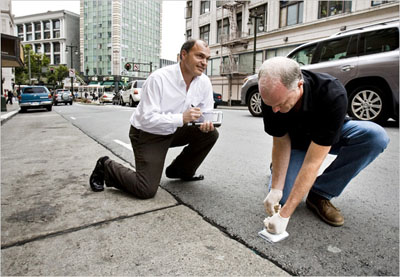New York is stuffed with sensors
Capital New York magazine has published an interesting article on how “the nervous system of our cyber city is growing”.
They describe all types of sensors that are installed in the city, and argue that surveillance cameras cover every corner of New York. In addition to them, there are also road cameras that track traffic congestion, cameras with infrared radars for recording speeding and photographing registration numbers, meteorological sensors, acoustic sensors installed in 30 US cities, determine the coordinates of firearm shots and car accidents, QR bar codes on garbage bins (citizens with smartphones are photographed if the tank is full), training QR bar codes at bus stops, etc.
There are separate private projects. For example, a sensor system on bicycle lanes to study the workload of bicycle routes and develop new ones (201,000 cyclists leave the roads of New York every day). Or a network of sensors in Washington Square Park to explore pedestrian patterns and congestion at different times of the day.
A relatively new project is the installation of Streetline parking sensors that look like white bumps on the road. These transmitters consume a minimum of energy (the charge lasts for several years), at the same time they communicate with neighboring sensors and merge information into a central database about whether a parking space is occupied or free.
')

Having downloaded the Streetline application on your mobile phone (Android, iPhone), you can search for a free parking space in real time. If such sensors are placed everywhere, the city authorities will be able to receive absolutely reliable information about the workload of parking lots in different parts of the city. Moreover, you can dynamically change the cost of parking. For example, if more than 50% of the seats are free, the cost is automatically reduced by 25%. If more than 80% of the places are occupied, the cost goes up by 50% and so on. Thus, the price of a parking space will be regulated by the market: increase or decrease until demand balances supply. This is good for the city budget and for car owners, because there will always be free places everywhere.
Capital New York journalists dream that someday all people will form a large network of sensors that can collect data everywhere. Technology for this is already there. For example, the French company Sensaris already distributes its Senspods sensors in Paris, San Francisco and Chicago. A small device is sewn into a bag, belt or bracelet and monitors information about the level of air pollution, noise and humidity around the clock. The data is transmitted via Bluetooth to the mobile application on the smartphone, and from there to the general map.
They describe all types of sensors that are installed in the city, and argue that surveillance cameras cover every corner of New York. In addition to them, there are also road cameras that track traffic congestion, cameras with infrared radars for recording speeding and photographing registration numbers, meteorological sensors, acoustic sensors installed in 30 US cities, determine the coordinates of firearm shots and car accidents, QR bar codes on garbage bins (citizens with smartphones are photographed if the tank is full), training QR bar codes at bus stops, etc.
There are separate private projects. For example, a sensor system on bicycle lanes to study the workload of bicycle routes and develop new ones (201,000 cyclists leave the roads of New York every day). Or a network of sensors in Washington Square Park to explore pedestrian patterns and congestion at different times of the day.
A relatively new project is the installation of Streetline parking sensors that look like white bumps on the road. These transmitters consume a minimum of energy (the charge lasts for several years), at the same time they communicate with neighboring sensors and merge information into a central database about whether a parking space is occupied or free.
')

Having downloaded the Streetline application on your mobile phone (Android, iPhone), you can search for a free parking space in real time. If such sensors are placed everywhere, the city authorities will be able to receive absolutely reliable information about the workload of parking lots in different parts of the city. Moreover, you can dynamically change the cost of parking. For example, if more than 50% of the seats are free, the cost is automatically reduced by 25%. If more than 80% of the places are occupied, the cost goes up by 50% and so on. Thus, the price of a parking space will be regulated by the market: increase or decrease until demand balances supply. This is good for the city budget and for car owners, because there will always be free places everywhere.
Capital New York journalists dream that someday all people will form a large network of sensors that can collect data everywhere. Technology for this is already there. For example, the French company Sensaris already distributes its Senspods sensors in Paris, San Francisco and Chicago. A small device is sewn into a bag, belt or bracelet and monitors information about the level of air pollution, noise and humidity around the clock. The data is transmitted via Bluetooth to the mobile application on the smartphone, and from there to the general map.
Source: https://habr.com/ru/post/113534/
All Articles